Whether you’re ready to get started or would like to know more, we’re here to help.
By Bruce Newton, carsales.com.au
Three significant trends have emerged – and changed – the Australian new-car market over the last decade: the rise and rise of dual-cab utilities, the proliferation of electrified vehicles and the arrival of Chinese car makers.
And all of those have converged into one new car, the 2024 GWM Cannon Alpha Ultra which recently launched as the first plug-in petrol-electric hybrid-powered dual-cab ute.
It takes us further down the road to zero-emission electric motoring and comes with a sharp price tag that challenges its most popular rivals, such as the Toyota HiLux and Ford Ranger. Let’s find out how.
How much does the GWM Cannon Alpha cost?
The 2024 GWM Cannon Alpha Ultra Hybrid is the flagship of the Chinese brand’s new GWM Cannon Alpha ute line-up and is priced at $64,990 drive-away.
The petrol-electric plug-less hybrid sits above other orthodox members of the range powered by a 2.4-litre turbo-diesel engine, including the entry-level Alpha Lux priced from $51,990 drive-away and the non-hybrid Alpha Ultra that costs $57,990 drive-away.
The Cannon Alpha is a larger version of the regular Cannon that has been on-sale in Australia since 2021 and is physically bigger than the likes of the HiLux and Ranger too.
What equipment comes with the GWM Cannon Alpha?
The flagship 2024 GWM Cannon Alpha Ultra Hybrid comes fully loaded with an extensive and impressive list of standard features.
On the outside, it rides on 18-inch alloy wheels, has LED headlights, lashings of chrome trim, roof rails and a panoramic sunroof, which is a rare inclusion in the ute segment.
Curiously, while the tray has a spray-in tub liner and lighting, it misses out on a sports bar – standard fit for most top-end utes – and a tonneau cover.
However, it does have the funkiest, smartest tailgate layout in the business. Depending on how long you press the button within the Cannon logo, it can split in two horizontally or do the expected thing and drop down in one piece.
It is quite handy depending on whether you’re loading or unloading small or large items or just checking on stuff in the tray. Hopefully, it’s robust enough to cope with inevitably rough treatment and roads.
Inside the cabin, the Ultra Hybrid has garish wood trim, soft-touch upholstery, leather-accented seats, dual-zone climate control with rear vents, an electric sliding rear window and 64-colour ambient lighting that can be set up to flash in time with music. Off thanks.
The seats are a story on their own. The driver gets eight-way power adjustment plus memory and a welcome function that pushes the seat back to make it easier to enter. The front passenger seat gets six-way power adjustment.
But that’s not all. The rear outboard seats power-recline to a very relaxed position, and they also get a welcome function and the ability to adjust the front passenger seat, just like in a luxury saloon.
Front and rear seats can be heated or cooled, and something called a ‘bladder massage’ is on offer for front seat passengers.
GWM is sure to sell a bunch of Alpha Ultra Hybrid utes based on the price and the impression they make standing in the showroom… Which is handy for reasons we’ll get to later.
The Cannon Alpha range is protected by a seven-year/unlimited-kilometre warranty, seven years’ roadside assist and seven years of capped-price servicing.
At the time of writing, GWM hadn’t released service intervals – it’s expected to be 12 months and 15,000km – or how much it costs for each visit to the workshop.
What technology does the GWM Cannon Alpha feature?
Reinforcing the GWM Cannon Alpha Ultra Hybrid’s sense of luxury is its huge infotainment screens, which dominate the dashboard.
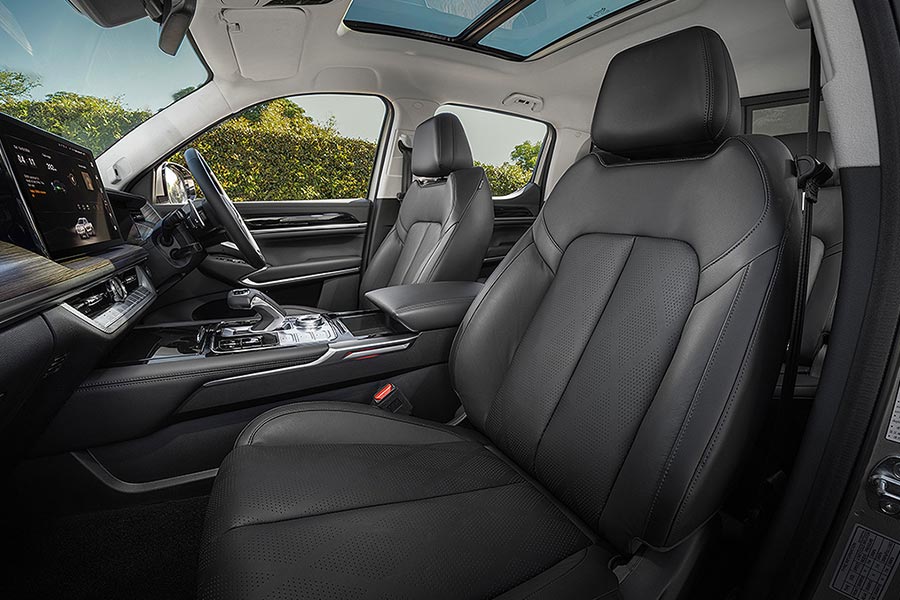
A 14.6-inch touch screen protrudes from the dashboard while a 12.3-inch instrument cluster is embedded in front of the driver. There’s also a head-up display projected onto the windscreen.
Within the infotainment system, it features wireless Apple CarPlay and wired Android Auto, embedded satellite navigation, Bluetooth connectivity, AM/FM and digital radio and a 10-speaker Infinity audio system. A connected car app is a new feature for GWM.
There are USB ports front and rear and, in a rare touch, wireless smartphone chargers in the rear as well as the front.
The Cannon Alpha also has voice recognition, but it just ignored me. It responded straight away to my colleague Nadine Armstrong though. So, go figure.
What is the GWM Cannon Alpha like inside?
Importantly, the GWM Cannon Alpha Ultra Hybrid does more than just tick boxes. The cabin is also filled with convenience while being spacious and comfortable.
The front seats are plush and supportive and there’s more space in the rear than its rivals, which makes the Alpha Ultra genuinely capable of adult-friendly long-distance travel. This thing could be an Uber.
There is no other ute this side of the full-size American pick-ups such as the Ford F-150 and RAM 1500 that provides this sort of pampering and real estate for their occupants. That the Ultra Hybrid does it for about half the money says a lot.
There are nice detail touches throughout the cabin, such as the softly damped cover in the centre console, a small sliding lid in the centre console bin, large door pockets with dividers and slide-out containers under the rear seats.
On the downside, the infotainment system requires too much drilling through the menu system to get stuff done.
For example, despite having a row of physical buttons for the air-conditioning, you still have to tap away into the touch screen to adjust temperature. And there’s nothing I could find on the dashboard to adjust the volume. Its either done through the steering wheel or touchscreen (or voice, if you can get it to pay attention).
The instrument cluster is a curiosity too. The space devoted to the speedo is small and there’s no permanent tacho.
There are two views on offer – one is a 3D graphic showing where the Alpha sits in traffic. Thanks, I have eyes. The other version bleeds the embedded sat-nav map across the screen. It can also display your smartphone map, but only a small portion of it.
There are other minor irritations. The circular black plastic key fob – shaped like the Cannon logo – is easy to get lost in the recesses of the storage bins; the driver doesn’t get an A-pillar grab-handle; the B-pillar is thick and obscuring for a head-check; and it’s easy to turn the headlights off when operating that bloody indicator stalk. Small things, for sure, but annoying nonetheless.
How safe is the GWM Cannon Alpha?
The GWM Cannon Alpha Ultra Hybrid has a comprehensive suite of driver assistance features with a baffling number of acronyms on the spec sheet.
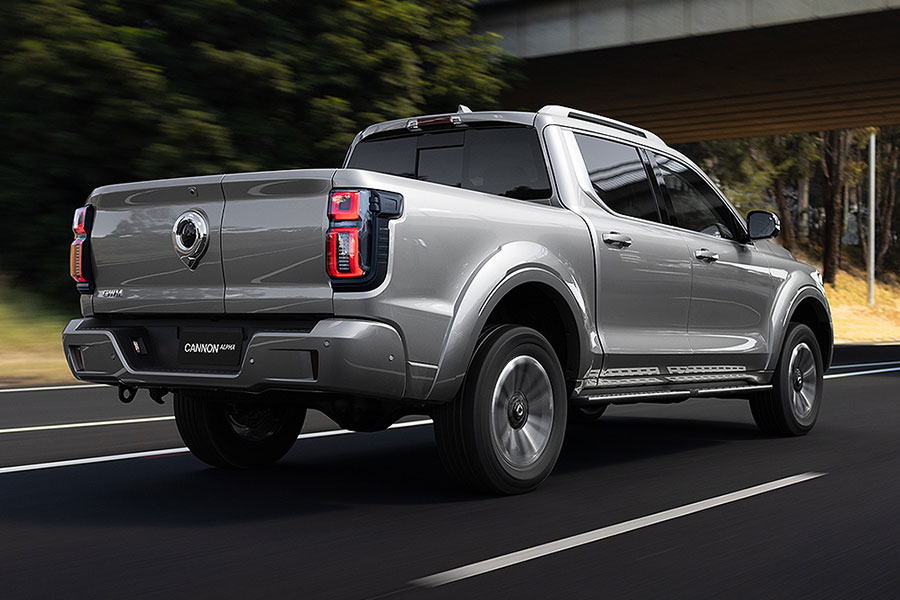
But what it boils down to is this: the Ultra Hybrid will automatically decelerate for obstacles front and rear, use its cameras and sensors to do its best to keep you in your lane, monitor blind spots, the driver, the speed limit, tyre pressures and – no doubt – much more.
There are seven airbags, front and rear parking sensors (12 in total), a comprehensive 360-degree camera with even a transparent chassis view, auto parking and an auto reverse function that tracks the car back the way it has come for a short distance. That’s handy for getting out of a narrow driveway at night, for instance.
GWM Australia is hopeful the 2024 GWM Cannon Alpha range will score a maximum five-star ANCAP rating based on the latest protocols. Usually, car companies avoid such bold predictions.
What powers the GWM Cannon Alpha?
The 2024 GWM Cannon Alpha Ultra is the first plug-in hybrid dual-cab ute available in Australia and borrows its powertrain from the GWM Tank 500 Hybrid SUV.
In fact, these two also share a significant amount of their underpinnings as well, in much the same way the Ford Everest SUV is based on the Ranger ute.
In this case, the GWM Cannon Alpha Ultra Hybrid combines a 180kW/380Nm 2.0-litre four-cylinder turbo-petrol engine tuned to the efficiency-chasing Miller Cycle with a 78kW/268Nm e-motor sandwiched in front of the nine-speed automatic transmission.
The e-motor is fed by a small 1.76kWh lithium-ion battery pack.
The combined output is claimed to be 255kW/648Nm. As we’ve previously pointed out, the torque number is interesting because it is the max outputs of the petrol engine and e-motor simply added up.
Often the combined torque number for hybrids is smaller than that because peak outputs are produced at different parts of the respective rev ranges. Toyota doesn’t even publish a combined torque figure for hybrids.
Further along the driveline, the Cannon Alpha and Tank 500 start to deviate. The ute has a part-time 4x4 system so it can’t run in 4x4 high range on grippy (bitumen) surfaces.
It does retain a transfer case with low range and front and rear locking differentials but misses out on the Tank’s unique wheel-locking tank turn and off-road cruise control. It has only three drive modes while the Tank 500 has nine.
How fuel efficient is the GWM Cannon Alpha?
GWM makes it quite clear that it developed the 2024 GWM Cannon Alpha ute’s hybrid system with a focus on performance rather than economy. That’s some good spin-doctoring, because its claimed average consumption of 9.8L/100km is no better than any of its turbo diesel-powered rivals.
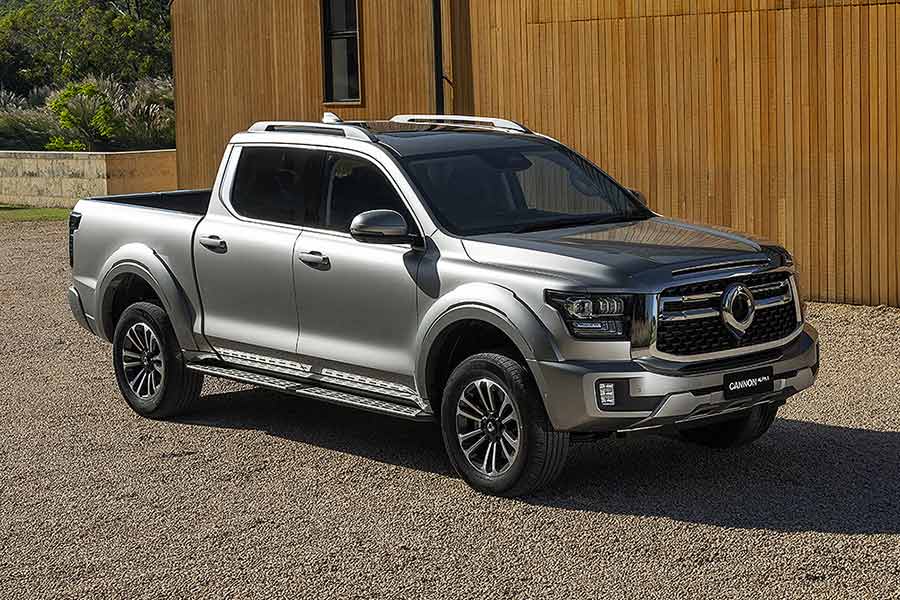
It does help the budget that the engine will run on regular 91RON unleaded though.
The tank (as in fuel, not 500) measures up at 80 litres so there’s a theoretically viable trekking range on offer.
In the real world, on a 650km trip with two passengers, a light load, lots of low-rpm freeway cruising and some suburban stop-start traffic returned a 10.9L/100km average.
That is going to spiral once you go off-road, tow or haul a load. Or do all three at once! So traditional diesel still has the upper hand on that score.
What is the GWM Cannon Alpha like to drive?
First, let’s consider what we’re dealing with here. The 2024 GWM Cannon Alpha Ultra Hybrid is only 35mm longer than the GWM Cannon Ute at 5445mm, 57mm wider at 1991mm and 38mm taller at 1924mm. But it has an extra 120mm between the front and rear axles at 3350mm, and it weighs in at 2575kg, so it’s big.
It is built on a rugged ladder frame with double-wishbone front suspension and a combination of leaf springs and a rigid axle at the rear. Steering is electric-assist rack and pinion, and disc brakes (ventilated up front) are employed all-round.
Alrighty then. You might remember the earlier reference to the importance of static showroom impressions in wooing buyers to the Cannon Alpha Ultra. That’s because it will lose friends once it starts rolling.
Not because the underlying mechanical package is seriously flawed. It’s all the stuff laid over the top that is the problem.
The lane keeping police snatch at the steering wheel (not as egregiously as some systems but still obviously), the driver monitoring goes off at the slightest hint your eyes have strayed from the straight ahead – even to look at the relevant info on the touch-screen – and then gives you a follow-up lecture. Every time.
Transgress the speed limit and a ‘bing’ gently resonates. Engage the adaptive cruise control and a disembodied voice reminds you to keep paying attention.
Ah, the cruise control… sheesh. For starters, the stalk is hidden out of sight behind the steering wheel spoke, which is not helpful. Then, at one point the resume function stopped working. And the minimum detection gap to the car in front was too conservative, so the Ultra would start to slow down well before it needed to.
If you do get too close to the car in front – according to the Alpha’s sensors – then red warnings flash in the instrument panel, accompanied by the inevitable beeps. The rear cross traffic alert also lit up at one stage when reversing out of my driveway and brought the car to a sudden halt for no apparent reason.
Activate the soft-touch indicators and it’s almost impossible to switch them off. If you see a Cannon Alpha driving straight ahead but alternately indicating left or right, it’s not because the driver is indecisive. It’s because the bloody indicators are so over-reactive.
Now some of this stuff can be switched off and it remains off. Some of it must be switched off every time the car is started. Naturally, it’s located under several different drop-down sub-menus in the touchscreen!
And some of it – like the cruise control admonishment and the crap blinkers – you just have to put up with.
If GWM could eliminate or reduce as many of these irritants as possible then it would have a decent ute.
The powertrain is responsive, although not as strong as the raw numbers suggest. It’s supposed to have more torque than a Ford Ranger Raptor, but it doesn’t feel like it. Part of that comes from the Ultra’s mass, but that alone isn’t the issue.
There are calibration issues that spoil its performance abilities, such as its unpredictable throttle modulation. Press the accelerator and … nothing … press more … a little response … press more …. Woah, a lot of response! It’s a bit like a Volkswagen dual clutch.
When it does work properly, the e-motor kicks in to provide a smooth and quiet take-off and then the petrol engine adds power and helps move the vehicle along at a lively rate. It’s a reedy, quiet noise under throttle and a very different experience to the usual clatter of a turbo diesel.
The calibration – there’s that word again – of the automatic is not the best either. There are clunks and shunts and a sense of gears not always meshing 100 per cent. It can also be busy down low with so many stacked gears to work through.
Perhaps the most frustrating bit is the hit-and-miss way the gear lever decides whether to engage, or not, or shift through drive into manual mode. Yep, that can be put down to operator error by not engaging the détente button properly. But does it have to be this fussy?
And what of the handling and steering? The latter can be tuned through three settings that noticeably varies the weighting, even if they are all consistent in the way they feel isolated from the vehicle. It’s not objectionable, just not convincingly integrated.
Unsurprisingly, the Ultra Hybrid feels big, long and ponderous on the road. It sets a course and tries to follow it.
Early-onset front-wheel pushing (understeer) is no surprise through tight bends and on slippery roads. But there’s also lots of intrusions from the conservatively tuned stability and traction control reminiscent of the way Toyotas used to shut down to a crawl.
The best dynamic trait of the Ultra is undoubtedly the way it rides. It’s a tad on the soft side at the rear, and there is a constant small patter on what looks like smooth roads and some frame shake on the rougher stuff, but it holds its composure surprisingly well overall.
Combine that with the cabin quietness and it’s a nice vehicle for long-distance highway travel.
How good is the GWM Cannon Alpha off-road?
As you’d expect, the 2024 GWM Cannon Alpha Ultra delivers some pretty impressive off-roading credentials.
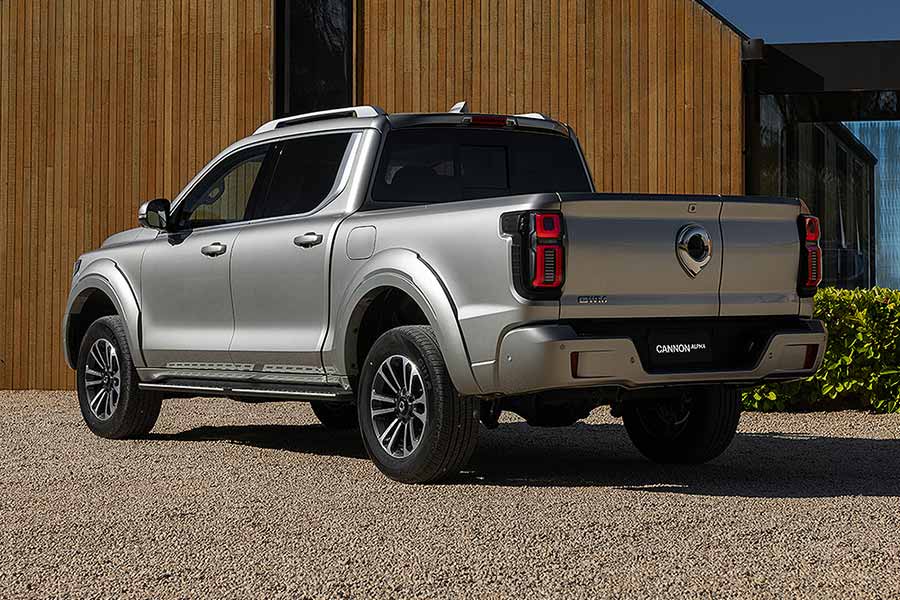
Looking at its numbers, it has is 224mm of ground clearance, the wading depth is 800mm, the approach angle is 28.5 degrees, the breakover 19 degrees and the departure angle 23 degrees. The turning circle is a sizeable 13 metres.
The combination of high and low range and diff locks mean the Ultra can deal with some quite challenging off-road obstacles.
The throttle modulation issues don’t make it all that easy though, particularly at low speeds. And it’s just getting to the size where it’s slightly harder to manoeuvre in the tight stuff than smaller utes like the Ford Ranger and Toyota HiLux.
How much can the GWM Cannon Alpha carry?
While the GWM Cannon Alpha Ultra Hybrid is pretty good off the beaten track, its workhorse capabilities are a little disappointing.
Its maximum payload is only 735kg and it’s too narrow between the wheel-arches to fit an Aussie pallet.
It can tow 3500kg braked – which is good – but, if you’re towing that much and you crunch the numbers on gross vehicle mass (GVM), the payload comes down to just 385kg, which is mediocre.
It is significantly better than the new Toyota HiLux SR5 48V auto (200kg), but is well shy of the Mitsubishi Triton GLS (665kg) and the Ford Ranger XLT biturbo (586kg).
Should I buy a GWM Cannon Alpha?
The 2024 GWM Cannon Alpha Ultra Hybrid ticks plenty of boxes on paper. It’s keenly priced, incredibly well equipped, backed up by a long and reassuring warranty and delivers sprawling space inside.
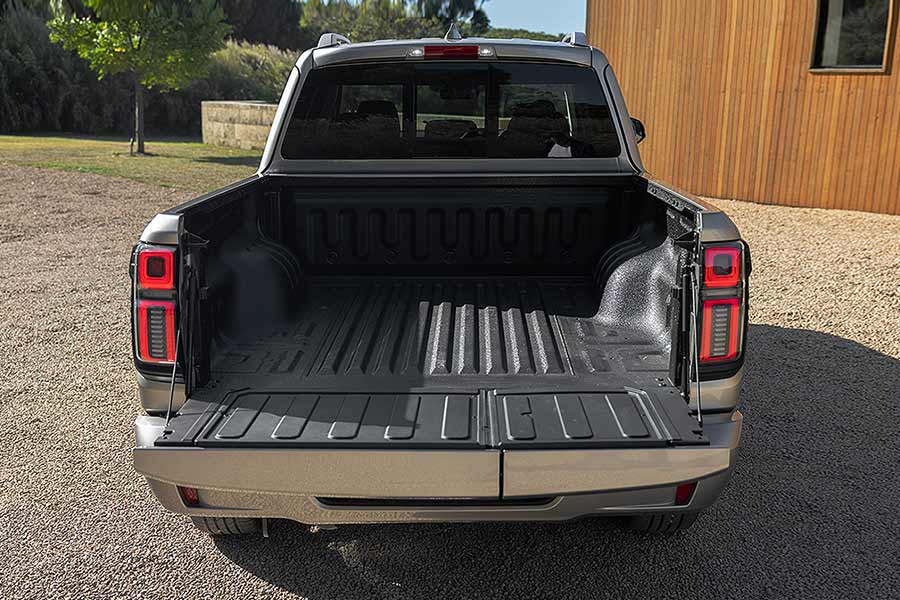
There’s also glimmers of evidence that the core driving experience – while a bit rough and rugged around the edges – has improved enough to at least be acceptable by the coarse standards applied to utes.
It is a very solid off-roader, and the overall performance of the hybrid drivetrain is proof that electrification can work for utes.
But there’s still many areas that need to be improved. The undersized payload – especially when towing – will put some people off, as will some of the drivetrain calibration shortfalls.
But ultimately the GWM Cannon Alpha Ultra Hybrid ute disappoints because of all the fussing and farting around with monitors and controls. They are just so crazily irritating it’s impossible to imagine living with them every day.
If that stuff was more sympathetically tuned, could be turned off once and left off (if appropriate) and the endless lectures extinguished, then this would be a brilliantly priced, exceptionally equipped ute, with ordinary but acceptable driving manners.
It could easily – and deservedly – become a best seller.
But for now, even if you like the GWM Cannon Alpha Ultra Hybrid in the showroom, make sure you drive it before signing your money over.
2024 GWM Cannon Alpha Ultra Hybrid at a glance:
Editor’s Rating: 6.9/10
| Price: $64,990 (drive-away) |
Transmission: Nine-speed automatic |
| Available: Now |
Fuel: 9.8L/100km (ADR Combined) |
| Engine: 2.0-litre four-cylinder turbo petrol-electric |
CO2: 225g/km (ADR Combined) |
| Output: 180kW/380Nm (electric motor: 78kW/268Nm) |
Safety Rating: Not tested |
| Combined output: 255kW/648Nm |
Disclaimer: Images supplied by GWM ANZ.
This article was prepared by an independent author. The information contained in this article represents the views and opinions of the original author, and is based on research carried out by the original author. The appearance of the article on Maxxia's website does not constitute an endorsement of its content by Maxxia in any way. The article has been made available for informational purposes only and should not be taken as advice. While all reasonable care has been taken to ensure that the statements made by the original author in the article are fair and accurate, Maxxia does not guarantee or warrant the accuracy or completeness of this information and will not be liable for, or in connection with, any loss or damage suffered as a result of any inaccuracies, errors or omissions or your reliance on this information. You should independently research and verify information before making any decision in respect of a vehicle.

